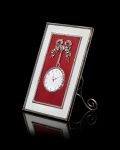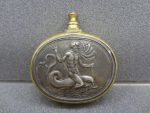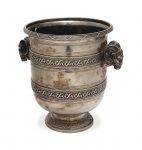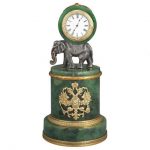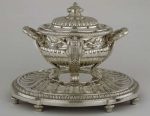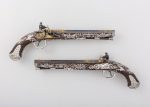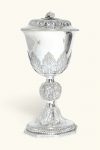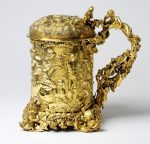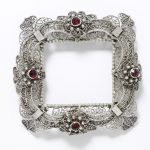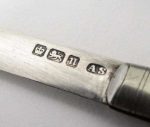The Neoclassical Style became popular in the second half of the 18th Century. Neo-classical Style is largely based on the classical styles of Ancient Greece and Rome. It was a popular style at the time mainly due to the travelling of wealthy Englishmen and the intereste in the archeological excavations of Pompeii and Herculaneum in the 1750’s. Rams Heads, Urns, Wreaths and Greek Key Borders were often used in silver designs with large areas often left plain. Neo-Classicism was linked to contemporary political events. It was also a replacement of the sensuality and triviality of the Rococo style with a style that was more logical, solemn and moralizing. Silver Makers often modelled candlesticks on the the classic fluted stone columns of the Greeks and Romans. When Napoleon I rose to power in France, the style was modified to serve his propagandistic needs.
A silver, gold and varicoloured enamel table clock Ivan Britzin, St. Petersburg, 1908-1917 rectangular form, front with circular clock mounted within neoclassical border and suspended from a tied silver bow, face with enamelled dial and gold hands, Swiss-made 15 jewel eight day movement, all against bright red translucent enamel over basket-woven engine turned ground, outlined with ribbon-tied reeded border, followed by a wide border in oyster white enamel over engine turned ground, reverse mounted with a silver scrolled strut, back panel is a modern replacement, 88 standard 18.2 x 12.2cm (7 1/2 x 4 3/4in).
Sold for £ 18,750 inc. premium at Bonhams in 2018
Gilded silver netsuke (flask-shaped). Neptune and dolphin, and key fret pattern.
This unusual metal netsuke is probably an imitation of a pocket watch of the type brought to Japan by Dutch traders. The case of the watch netsuke has a simulated winder stem at the top, and the silver cover is beautifully carved with a European neoclassical design of Neptune riding on a dolphin-like sea creature amid waves. On the back of the watch, a floral design surrounded by a fret pattern is delicately carved into the gilt metal ground. A ring is attached to facilitate use as a netsuke.
Reference: © The Trustees of the British Museum
A NEOCLASSICAL-STYLE FRENCH SILVER WINE COOLER, EARLY 20TH CENTURY, marked ‘.950’ standard with silver-plated liner 8¾in. (22.2cm.) high, 55oz. approximate weighable silver (2)
Sold for USD 5,000 at Christie’s in 2012
Russian Neoclassical Style Silver and Silver Gilt Mounted Green Jade Animalier Desk Clock 20th Century In the form of a striding elephant supporting a flat circular clock case on its back, enclosing a white enameled dial with black Roman numerals, on a truncated stepped columnar base with the Imperial double headed eagle, inset with colored stones. Height 7 7/8 inches.
Sold for $2,375 (includes buyer’s premium) at Doyle New York in 2012
Austrian neoclassical ornate silver centerpiece with brass insert. Accented with a winged angel on pedestal with paw fee on both sides, laurel wreaths and swags hang from bows along the rim, handles on opposite ends. Marked with Diana silver mark & Vienna marks MG. Total troy ounces 62.69, does not include the liner.
Sold for $1,400 at Abington Auction Gallery in 2018
Pot à oille (ragout tureen) and stand
The Louvre tureen sits on a scalloped circular stand, the stand supported on little acorn feet and the scallops accentutated with waterleaf decoration. Four wide consoles, each covered with a frieze of coin-like motifs, constitute the feet of the tureen, and the whole is fluted and decorated with laurel leaves. The lid has the same scalloped decoration as the stand and an engraved frieze of a meander pattern as a border. All these types of ornament were inspired by the decorative repertory of Greco-Roman antiquity, in which there was a renewal of interest in the 1760s. Silversmithing being a relatively conservative art, stylistic innovations did not have immediate repercussions in silverware. As a result, intermediate styles are few and far between, and for this reason the Orloff service, whose design is still informed by the rounded (though now less apparent) forms of rococo, marks an important stage in the history of silverware.
Reference:The Louvre
Pair of Flintlock Pistols Gunsmith:Samuel Brunn (English, London, recorded 1795–1820) Silversmith:Marked for Michael Barnett (English, London, 1758–ca. 1823) Date:hallmarked for 1800–1801
These pistols are among the finest known examples of English Neoclassical-style firearms. Each stock is inlaid with engraved sheet silver and embellished with heavy cast-silver mounts. This decoration was inspired by contemporary French Empire firearms, such as those by Boutet also in the Metropolitan Museum’s collection (acc. nos. 36.58a–c, 42.50.7a–n, and 1970.179.1). Several of the motifs are based on ancient Roman sources. On the sideplate, for example, the Nereid riding a sea-leopard derives from an engraving of 1762 depicting a wall painting in the recently found ruins of Herculaneum. On the trigger guard, the oval medallion representing Hercules with a defeated Amazon is copied from a well-known antique gem. The Medusa head on the butt also derives from Classical art, but here the idealized model has been transformed into a grimacing, almost humorous caricature of the legendary gorgon.
Reference: The Metropolitan Museum of Art
Silver goblet featuring reproduction from Panthenon Frieze Made 1887 This silver goblet is decorated with classical-style horses and riders inspired by those from the north frieze of the Parthenon in Athens. Sir James Martin (1820-86), whose crest is engraved on one side, favoured the Grecian style over the rival neo-Gothic style. Martin’s advocacy of the classical extended to his famous garden at his house, Clarens, in Sydney’s Potts Point. Here, Martin had a sandstone replica erected of the choragic monument of Lysicrates (built 335 BC Athens) which with subdivision of the property was re-sited to Sydney’s Royal Botanic Garden where it still stands.
Reference: Museum of Applied Art and Sciences
A German silver covered chalice, Friedrich Wilhem Wilkens, Bremen, circa 1830 the bowl and base with applied acanthus leaves, the spherical stem chased with fruiting vines, the lobed cover with styled grape bunch finial, the bowl engraved: Georgio Augusto Heineken, d. 26 Maye 1830, Giorgia Augusta, each facet of the octagonal base engraved with a name, in a fitted case, 25.2cm., 10in. high, together with a Sheffield Plate samovar, circa 1800, neoclassical urn form with lion mask drop-ring handles, ivory tap handle 33cm., 13in. high 545gr., 17oz. 8dwt.
Sold for 1,750 GBP at Sothebys in 2017
Cylindrical tankard, the base with applied grapevine and dolphin feet, the body cast and chased with mythological scenes of Mount Olympus, the handle decorated with grapevine and bacchanalian figures, the domed, hinged cover with cast and chased putti and the finial in the shape of a putti.
This exceptionally heavy tankard must have been designed for display rather than for use as a drinking vessel. It is one of the earliest pieces of silver made by the silversmith Edward Farrell. The design is largely based on that of late 17th century German tankards but is more eclectic incorporating neoclassical and baroque stylistic elements. The frieze of the gods on Mount Olympus is Neoclassical in execution and subject matter whereas the heavy, exuberant decoration on the base, handle and cover of the tankard owes much to the Baroque. 1817-1818 (made)
Reference: © Victoria and Albert Museum
